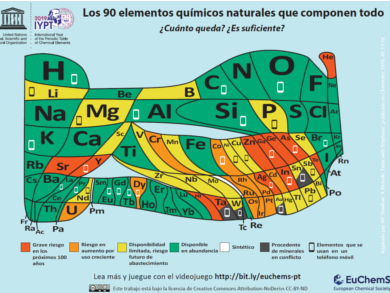EuChemS Periodic Table of Element Scarcity
UNESCO has proclaimed 2019 the “International Year of the Periodic Table of Chemical Elements (IYPT2019)”. The School of Technology and Experimental Sciences (ESTCE) of the Universitat Jaume I, Castellón, Spain, put up a large periodic table in their entrance hall (see Fig. 1). This is one of their activities to join the IYPT2019 and to commemorate the first periodic table Dmitri Mendeleev published 150 years ago.
The periodic table measures four by three meters and depicts the scarcity of the elements. It was created by the European Chemical Society (EuChemS). The area occupied by each element gives an indication of the quantity of this element in the earth’s crust and in the atmosphere. It contains only the 90 naturally occurring elements. The color code shows how fast we are consuming the elements in relation to their availability. If we keep up this rate of consumption, the availability of some elements will soon become limited unless new ways to recycle them are found.

Figure 1. Professors, researchers, and students of the Chemistry Department at the School of Technology and Experimental Sciences (ESTCE) of the Universitat Jaume I, Castellón, Spain, celebrate the IYPT2019 with EuChemS’s Element Scarcity Periodic Table.
Lecturers, students, and members of the administrative staff working in the departments related to chemistry took the group picture with the EuChemS’s periodic table (see Fig. 1). The idea came from the Scientific Culture and Innovation Unit of ESTCE. They were inspired by photos with the EuChemS periodic table Professor Eduardo Peris had taken during lectures.
In general, displaying the periodic table in the ESTCE entrance hall, a high-traffic area which many students, lecturers, and administrative staff pass daily, has been a success in giving it visibility. From the beginning, the canvas with the periodic table caught the attention and stimulated the curiosity of students and lecturers.
As a general reaction, most people first found the periodic table a little strange and were interested in the different form of this table, its shapes, sizes, and the colors of the elements. All agreed that this version of the table and its exhibition in the hall of the school, helped them a lot to become aware of the problems of sustainability, scarcity, and overexploitation of some of the chemical elements. These elements are the “construction blocks” of everything that exists and everything that we know.
On April 5, 2019, there will be a Special Dissemination Day for the IYPT2019 at ESTCE, organized as a scientific “mini-congress”. Together with various external guest lecturers with experience in science communication, ESTCE students will actively participate by presenting ca. 25 posters and several papers on the elements or groups of the periodic table.
Chemistry on the Radio
In addition, the university is broadcasting a radio program, “La Tabla Periódica de Los Elementos”, broadcasted within the program “Una Finestra a la Ciència” (“A Window to Science”) via the university’s radio station Vox UJI Ràdio. It is produced by the Scientific Culture and Innovation Unit of the Communication and Publications Service. Una finestra a la Ciència talks about research and news related to the science done at the university.
The program is aimed at the entire university community, although it can also be used for pre-university students studying the periodic table of chemical elements. The aim of the program is to give visibility to the elements: their characteristics, properties, applications, and some curiosities. “The IYPT2019 is a good excuse to carry out this dissemination program.”, the organizing team said.
An email was sent to all chemistry Bachelor’s students and everybody was invited to participate. Four chemistry students, Adrián Fernández, Ana María López, Héctor Llanos, and Óscar Navarrete, participate in the development of two parts of the program: on noble gases and on halogens. It is a new experience for them; they had not previously participated in a radio program.
It can be a challenge for the students to talk about a subject they know, but in a way that is aimed at a broad audience and in a medium such as radio. The intention is that they become familiar with the medium and that they gain experience in scientific communication.
The students have prepared the scripts for the two parts. The Scientific Culture and Innovation Unit has reviewed the scripts and made some suggestions on the content and some recommendations on good language for a radio program. The students will record the two programs now and it will be broadcast in June.
The script of the program was compiled by Empar Vengut, Ph.D. in Biological Chemistry and currently at the University of Valencia, Spain, with some contributions from Mari Luz Blanco. “Neither of us had produced similar programs before, it was our first experience. Although as a journalist, I belong to the field of social sciences, the “pure” sciences and, in particular, chemistry have always pleased me a lot. It was such an interesting challenge!”, Mari Luz Blanco said.
- Una finestra a la ciència, VoxUJI Radio February 6, 2019.
- L’ESTCE de l’UJI se suma a la celebració de l’Any Internacional de la Taula Periòdica, UJI, February 2019.
- The ten parts of the program:
1. Periodic table. Mendeleiev and other scientists. Elements known so far. Why is it periodic? Curiosities (8-2-2019)
2. Alkaline metals (1-3-2019)
3. Alkaline earth metals (15-3-2019)
4. Transition metals (5-4-2019)
5. Post-transition metals (3-5-2019)
6. Lanthanides (17-5-2019)
7. Actinides (31-05-2019)
8. Semimetals or metalloids (14-06-2019)
9. Halogens (28-06-2019)
10. Noble gases (28-06-2019)




